Bariatric surgery is a safe and effective treatment option for those living with severe obesity and for some living with obesity combined with other obesity-related conditions. These procedures are recognized for the metabolic and hormonal changes that have a role in hunger (wanting to eat) and satiety (feeling full). They also play a role in the improvement and/or resolution of conditions that can occur as a result of obesity and severe obesity.
Bariatric surgery is a recognized and accepted approach for both weight loss and treatment of many of the conditions related to obesity. However, not everyone qualifies for bariatric surgery. There are certain requirements people must meet in order to be a candidate for bariatric surgery.
In addition to bariatric surgery, FDA-approved bariatric devices are available for the treatment of obesity. These devices are not approved for the treatment of severe obesity.
Important Things to Remember:
- It is important to note that there are risks involved with all surgeries and medical procedures, including those for obesity and severe obesity. Before making a treatment decision, it is important to discuss these risks with your primary care provider and/or surgeon. The OAC also encourages individuals to discuss these risks with their family members.
- The OAC uses the term “total body weight loss” when discussing bariatric surgery and procedure options. You may encounter materials from your primary care provider and/or surgeon that use the term “excess body weight. ” To be fully informed of actual, potential weight-loss results, ask your provider which method they are using when discussing surgical options for weight loss.
Could You be a Candidate for Bariatric Surgery?
In 1991, the National Institutes of Health (NIH) issued a statement declaring bariatric surgery an effective approach for consistent, long-term weight loss for people with severe obesity. The NIH also established the following criteria for candidacy for bariatric surgery:
- Body mass index (BMI is a measure of weight relative to their height) thresholds of:
- A BMI > 40 or weighing more than 100 pounds over an ideal body weight.
- A BMI between 35 and 40 combined with certain obesity-related conditions such as type 2 diabetes, high blood pressure, sleep apnea and high cholesterol.
- No endocrine causes of obesity (hypothyroidism, polycystic ovarian syndrome, etc.).
- There is an acceptable operative risk (the procedure does not put the patient at undue risk).
- The patient understands the surgery and its risks.
- The patient does not have a drug or alcohol addiction.
- The patient does not have uncontrolled psychological conditions.
- The patient has had failed attempts at weight-loss (diets and other weight-loss options). If you believe you might be a candidate for bariatric surgery, you will need to consult with your primary care provider (PCP) and insurance provider.
Benefits:
Within two to three years following bariatric surgery, patients usually have a weight-loss of 10-35% of their total (pre-surgery) body weight. Results depend on the procedure and vary by individual. If you are considering bariatric surgery, talk with your PCP about what your personal expectations for weight-loss should be.
Bariatric surgery can often help with obesity-related conditions such as type 2 diabetes, high blood pressure, sleep apnea and others. Quite often these conditions are reduced in severity or go into remission. Many surgery patients find they need fewer medicines following surgery and may be able to discontinue some completely.
Risks:
Research has shown that some patients who have bariatric surgery have unsatisfactory weight loss or regain much of the weight they lost following surgery. Some lifestyle behaviors such as frequent snacking on high-calorie foods or a lack of exercise can contribute to less weight-loss and to weight regain. Surgical complications (such as separated stitches) may also contribute to less weight loss. Additional complications exist for different surgeries and devices and are discussed in the following pages.
Please remember, bariatric surgery is not “an easy way out.” It is a treatment option that is one tool patients use to lose weight.
Surgery is a resource to help reduce weight and improve weight management. Lifestyle modifications, including healthy eating,
portion control, physical activity and psychological changes, are needed to meet and maintain weight-loss goals.
Commonly Used Terms for Bariatric Surgery
In this section, you will see terms you may not be familiar with. Here you will find a brief description of these terms as they are used when talking about bariatric surgery.
Open, Laparoscopic and Robotic-Assisted Procedures
In each section, you will see surgeries described as being performed open, laparoscopic. Robotic-Assisted is also another method currently used. Currently, laparoscopic procedures are more common than open procedures. Your surgeon will decide which approach to use. It will depend on several factors, including surgeon’s experience as well as your surgical and medical history. This may influence one approach being used over the other. Please be sure to discuss the surgical approach that will be used with your surgeon.
- Open – An open procedure involves a single incision that opens the abdomen, which provides the surgeon access to the
abdominal cavity. The incision can vary in length from as little as three inches to as large as six or more inches. - Laparoscopic – In laparoscopic surgery, a small video camera is inserted into the abdomen through a small incision. This allows the surgeon to conduct and view the procedure on a video monitor. Both the camera and the surgical instruments are inserted through small incisions made in the abdominal wall. The number of incisions will vary depending on the surgical procedure and the surgeon’s experience. Some surgical procedures can be performed with a single incision, while other procedures may involve six or more small incisions.
- Robotic-Assisted – While the word “robotic” is in the description, a robot doesn’t perform surgery. Your surgeon is the one performing surgery using the instruments and enabling features the robotic system offers. With the robotic system, your surgeon sits at a console near you in the operating room. Through the console, the surgeon controls a camera and the tiny instruments used to perform your surgery through a few incisions about the size of your fingertip. The system delivers 3D high-definition views, giving your surgeon a crystal-clear view of the surgical area magnified 10 times what the human eye sees. It translates every movement your surgeon makes in real time, bending and rotating instruments that move like a human hand, but with a greater range of motion. Built-in tremor filtration technology helps your surgeon move each instrument with smooth precision.
Metabolic vs. Non-metabolic
The operations in this category help patients lose weight by altering their gastrointestinal (GI) tracts. Examples include the vertical sleeve gastrectomy (VSG), Roux-en-Y gastric bypass (RNYGB), and the biliopancreatic diversion with duodenal switch (BPD/DS).
Metabolic Operations – These operations help patients lose weight by altering their GI tracts. By doing this, a patient’s physiological response to fat loss is changed. Metabolic surgery changes the way your gut hormones are secreted. This change greatly reduces feelings of hunger, which is helpful when attempting to lose weight. Recent research indicates that bariatric surgery works in two ways:
- The procedure itself
- The metabolic changes that occur in the gut hormones due to the surgery
Numerous studies have examined pre-operative and post-operative gut hormone levels after bariatric surgery. A brief summary of hormonal changes after each bariatric procedure is provided in the next sections. Some of these hormones are:
- Ghrelin: functions primarily to stimulate appetite.
- Glucagon-like peptide 1 (GLP-1): works to have increased satiety (fullness) and reduced stomach emptying.
- Peptide YY (PYY): reduces appetite and increases the efficiency of digestion and nutrient absorption.
Non-metabolic Operations – The options in this category provide significant weight-loss without altering the physiology of energy (fat) storage. One example is the laparoscopic adjustable gastric band (LapBand®). They are considered non-metabolic options because they do not alter the body’s normal mechanisms that occur when dieting. With bandings and with dieting, orexigenic hormones (appetite stimulant) increase, and anorexigenic (appetite suppressant) hormones decrease.
Bariatric Surgery Options
It is no small task to choose a weight-loss treatment option. There are many choices, various costs, associated risks, and many benefits. It is our goal to provide you with background information for the different types of bariatric surgeries and devices. This can help you when having a discussion with your physician about the best treatment options for you.
Bariatric surgery requires proper follow-up and participation in an integrated program that stresses lifestyle modifications (dietary, behavioral and exercise changes). This will improve the chances for a bariatric surgery patient to maximize their weight loss and maintain it for a lifetime.
Bariatric Surgical Procedures Include:
- Adjustable Gastric Banding (LAP-BAND®)
- Sleeve Gastrectomy
- Roux-en-Y Gastric Bypass
- Biliopancreatic Diversion with Duodenal Switch
Qualifications for Sleeve Gastrectomy, Roux-en-Y Gastric Bypass, and Biliopancreatic Diversion with Duodenal Switch are all the same. However, LAP-BAND® has different criteria. The LAP-BAND® has been FDA-approved for patients with a lower BMI (BMI is at least 40 or with a BMI of at least 30 with one or more obesity-related conditions).
Please be sure to discuss the various surgical options with your physician to determine which procedure is best for you and your medical and surgical history.
Adjustable Gastric Banding (Non-Metabolic)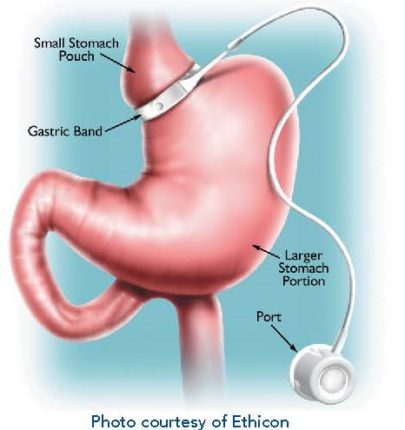
What is Adjustable Gastric Banding and how is it performed? An example of an adjustable gastric banding is the LAP-BAND®. This operation involves placing a silastic “belt” around the upper part of the stomach. The “belt” essentially separates the stomach into two parts: a tiny upper pouch and a larger lower pouch.
The band is connected by tubing to a port (filling reservoir) that sits below the skin of the abdominal wall, usually around the belly button (the port site varies widely by surgeon). The port cannot be seen (and often cannot be felt) from the outside.
Inside of the “belt” is a balloon that can be filled with fluid through the port. As the balloon is filled, it slows the passage of food from the upper pouch into the lower pouch. As the band is progressively filled, patients will feel more “full” with smaller amounts of food. You will work with your surgeon to determine the number of band fills or adjustments appropriate for you.
Weight-loss: Weight loss with an adjustable gastric band is typically slow and steady. Band patients generally lose one to two pounds per week during the first year after band placement. On average, by year one, band patients lost approximately 14% of their total body weight (weight at time of procedure). In a 350 pound person, this would mean a 49-pound weight loss. By year three, band patients lost approximately 15.9% of their total body weight (weight at time of procedure).
Metabolic/Hormonal Changes: With this procedure, there are minimal metabolic and hormonal changes.
What are the Benefits of Gastric Banding? There are several features that make the adjustable gastric band appealing.
- There is minimal stress to the body at the time of surgery because the band is almost always placed laparoscopically
and does not involve cutting the stomach or rerouting the intestines. - Most patients can go home the same day or the next morning.
- Recovery from surgery is usually quick, and most people return to work a week or so after surgery.
- The adjustability of the band makes it unique among weight- loss operations. This feature allows the possibility of making band adjustments based on the individual weight-loss goals and needs of the patient.
- The stomach and intestines are not bypassed, so vitamin, mineral, and nutrition problems after banding are less common. However, many programs still recommend taking vitamin supplements after banding.
- While it is a non-metabolic procedure, some patients have reported a reduction in feelings of hunger.
Complications: Patients contemplating adjustable gastric banding must be comfortable with the thought of having a medical device in them for life. Although the band has an excellent safety profile, some complications can occur with any weight-loss operation, and the band is no different. It is important for patients to have routine follow-up appointments with their healthcare team for adjustments and monitoring.
About 30-50% of patients will require a second operation to address a problem with their band.
Potential complications include band slippage or gastric prolapse, band erosion through the stomach, or tubing leakage. The risk of death from band surgery is equal to or less than 0.1% (1 in 1000) within 30 days after surgery. However, many centers report even lower rates. The adjustable gastric band can be removed, if necessary.
It is important to realize that the band is not a short-term fix. It is intended to be left in your body indefinitely. As with other medical devices implanted in the body, long-term effects (20 to 30 years) are unknown at this time with the band.
In the first year after surgery, when band adjustments may be required more frequently, patients need to be available for regular follow-ups with their healthcare team. In deciding if banding is right for you, it is important to consider both the time and distance involved in traveling to where the adjustments will be performed. Adjustments are made by filling the band through the port with fluid through a needle.
Band patients do not suffer adverse effects from eating sugars (dumping syndrome), so they need to be more disciplined in their food choices. Foods and beverages like sodas, ice cream, cakes, and cookies slide through the band easily. These choices will not lead to the desired goal of significant weight-loss.
Conclusion: Adjustable gastric banding is an effective weight-loss operation that can lead to meaningful, long-term weight-loss. No matter what weight-loss operation is chosen, individuals need to change their lifestyle and learn to work with the band to be successful.
Sleeve Gastrectomy (Metabolic)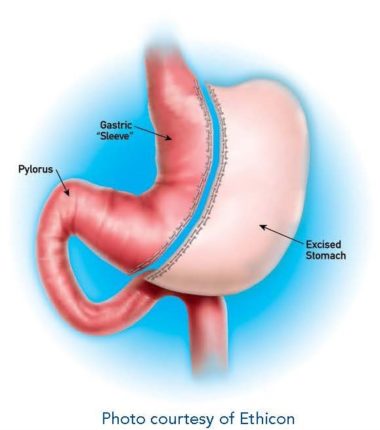
What is a Sleeve Gastrectomy? The sleeve gastrectomy (LSG) is part of another bariatric surgery option. LSG is the restrictive part of the duodenal switch operation. Recently, it has been used by some surgeons as a staging procedure before a duodenal switch in very high- risk patients. It has also been used as a stand-alone procedure for some patients.
How is the Sleeve Gastrectomy performed? The majority of LSG’s performed are completed laparoscopically. During the LSG, about 75% of the stomach is removed. This leaves a narrow gastric tube or “sleeve.” No intestines are removed or bypassed during this procedure and it generally takes about one to two hours to complete. When compared to the gastric bypass, the LSG can offer a shorter operative time that can be an advantage for patients with severe heart or lung disease.
Weight-loss: The LSG procedure greatly reduces the size of the stomach and limits the amount of food that can be eaten at one time. It does not cause decreased absorption of nutrients or bypass the intestines. After this surgery, patients feel full after eating very small amounts of food. LSG may also cause a decrease in appetite. On average, by year three, sleeve patients lost approximately 21% of their total body weight (weight at time of procedure). In a 350 pound person, this would mean a 74-pound weight loss.
Metabolic/Hormonal Changes: In addition to reducing the size of the stomach, the procedure reduces the amount of the “hunger hormone,” ghrelin, produced by the stomach. The duration of this effect is not clear yet, but most patients have significantly decreased hunger after the operation.
- Decrease Ghrelin = Decrease hunger
- Increase PYY = Increase satiety
- Increase GLP-1 = Increase satiety
Complications: LSG has been used successfully for many individuals affected by severe obesity. Since it is a relatively new procedure, there is no data regarding weight-loss or weight-regain beyond three years. The risk of death from LSG is 0.2% (2 in 1000) within 30 days after surgery. The risk of major postoperative complications after LSG is 5-10%, which is less than the risk associated with gastric bypass. This is primarily because the small intestine is not divided and reconnected during LSG. This lower risk and shorter operative time is the main reason for use as a staging procedure for high-risk patients.
Complications that can occur after LSG include:
- A leak from the sleeve can result in an infection or abscess
- Deep venous thrombosis (blood clot) or pulmonary embolism
- Narrowing of the sleeve (stricture) requiring endoscopic dilation
- Bleeding
Major complications requiring re-operation are uncommon after sleeve gastrectomy and occur in less than 5% of patients.
Conclusion: LSG is a bariatric surgery procedure that can lead to significant weight-loss. As with any bariatric surgery procedure, the best results are achieved when the surgery is combined with a multi-disciplinary program that focuses on lifestyle and behavioral changes.
Roux-en-Y Gastric Bypass (Metabolic)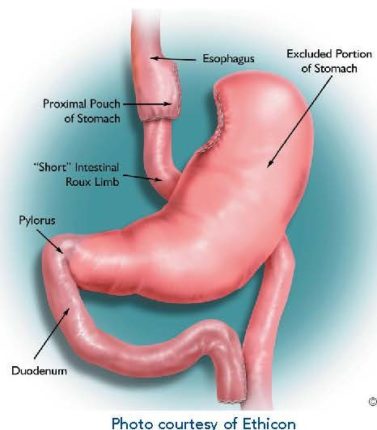
What is a Roux-en-Y Gastric Bypass? The Roux-en-Y gastric bypass operation has been performed since the late1960s’as a treatment for people affected by severe obesity. The operation leads to weight loss through two ways:
- A small stomach pouch reduces the amount you can eat.
- A small amount of intestine is bypassed, leading to an earlier hormones that make you feel less hungry.
How is it performed?
A gastric bypass can be done through a single long incision (open) or through series of small incisions (laparoscopic). No matter how the operation is done, the “inside part” is the same.
The surgery involves three basic steps:
- Dividing the large stomach into two separate stomachs, creating a small pouch (proximal pouch of stomach) and a larger excluded lower pouch (remnant pouch of stomach).
- Bypassing part of the small intestine (creating the “Short” Intestinal Roux Limb).
- Attaching the bypassed intestine (Roux Limb) to the proximal pouch.
The operation can usually be done in two hours or less, but it will depend on many factors. Most patients will need to stay in the hospital for two to three days after their operation and should be ready to return to full activity within two weeks.
How does it work? To understand how a gastric bypass leads to weight loss, it is helpful to review what you probably learned in grade school: human digestion.
When we swallow food, it goes down the esophagus and into the stomach. The stomach can hold huge amounts of food (think about a hot dog eating contest). The stomach then churns the food and mixes it with digestive juices to break the solid food down into a liquid form. That liquid food then leaves the stomach and goes into the small intestine where it can be absorbed to help fuel our bodies.
The small gastric pouch created during the gastric bypass limits the amount of food (calories) a person can eat during a meal. The pouch will initially hold a very small amount of food (about half a shot glass full or one tablespoon). However, by one-year post-surgery, a gastric bypass patient will be able to eat a meal equal in size to what a seven or eight-year-old child typically eats. Although the meals after gastric bypass surgery are much smaller than what they were before surgery, they still give the individual the same feeling of being full they used to get with a much larger meal. Until food is broken down into the liquid form, it cannot be absorbed by the small intestine. After a gastric bypass, the food does not turn into liquid until it leaves the “Short Intestinal Roux Limb” (see the image of gastric bypass). The “Short Intestinal Roux Limb” therefore does not absorb all of the nutrients from food that is eaten (called malabsorption). This also means vitamins and minerals aren’t as well absorbed, so gastric bypass patients must be on vitamin and mineral supplements for the remainder of their life.
The “Short Intestinal Roux Limb” does not handle sugar or starches well, so gastric bypass patients must limit their intake of sugary and starchy foods. If they don’t, they may experience something referred to as dumping syndrome. Usually 10-15 minutes after eating a sugary or starchy food, the individual who is “dumping” begins to experience many of the following symptoms:
- Sweating
- Flushing skin
- Rapid heart rate
- Dizziness
- Low blood pressure
- Abdominal pain
- Vomiting
- Diarrhea
- Shakiness
- Fainting
Dumping can last for 30-45 minutes before going away. Limiting sugars and starches will limit dumping. For many people who have had a gastric bypass, dumping, or the fear of dumping helps them make better food choices and stay away from foods that have tempted them in the past.
Weight-loss: On average, by year one, bypass patients lost approximately 34% of their total body weight (weight at time of procedure). In a 350 pound person, this would mean a 119-pound weight loss. By year three, bypass patients lost approximately 31.5% of their total body weight (weight at time of procedure).
Metabolic/Hormonal Changes: In addition to reducing the size of the stomach, the procedure reduces the amount of the “hunger hormone,” ghrelin, produced by the stomach. The duration of this effect is not clear yet, but most patients have significantly decreased hunger after the operation.
- Decrease Ghrelin = Decrease hunger
- Increase PYY = Increase satiety
- Increase GLP-1 = Increase satiety
Complications: The major complications with gastric bypass include bleeding, leakage, infections, bowel blockages, blood clots in the lungs (pulmonary emboli), and death. The chance of dying in the first 30 days after a gastric bypass is around 0.2 – 0.5% (2 to 5 in 1000).
Long-term complications that can occur after a gastric bypass include strictures, ulcers, hernias, weight regain, vitamin and mineral deficiencies, and malnutrition. Most of the long-term problems linked to the gastric bypass operation can be prevented by follow-up appointments with your healthcare team.
Conclusion: Gastric bypass is a weight-loss operation that can lead to significant and sustained weight-loss by reducing food intake and altering gastrointestinal hormones. While there are short and long-term risks associated with the surgery, most of these issues can be prevented. As with any weight-loss operation, the best results are achieved when the surgery is combined with a program that also focuses on lifestyle and behavioral changes.
Biliopancreatic Diversion with Duodenal Switch (Metabolic)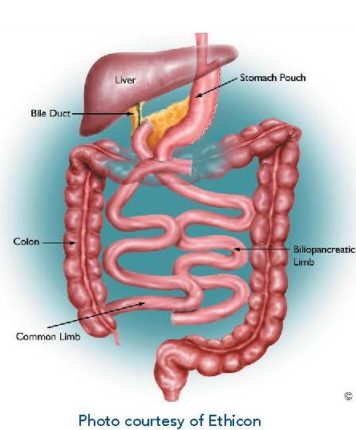
What is a Biliopancreatic Diversion with Duodenal Switch? The Biliopancreatic Diversion with Duodenal Switch (BPD/DS) is often an open operative procedure. However, it can also be performed laparoscopically.
How is the Biliopancreatic Diversion with Duodenal Switch performed? The outer part of the stomach is removed (approximately two thirds—similar to a sleeve gastrectomy), and the intestines are rearranged to shorten the area where the food mixes with the digestive juices.
A portion of the stomach is left with the pylorus still attached and the duodenum beginning at its end. The duodenum is then divided, allowing for the pancreatic and bile drainage to be bypassed. It is a pyloric saving procedure which eliminates the “dumping syndrome” that is inherent to gastric bypass.
Weight-loss: This procedure results in decreased absorption of fat, calories, and other nutrients which may result in increased weight loss. Foods high in fat content are not easily absorbed and will be eliminated along with the usual high calories associated with the high-fat. On average, by year three, BPD/DS patients lost approximately 35% of their total body weight (weight at time of procedure). In a 350 pound person, this would mean a 123-pound weight loss.
As in all bariatric surgery procedures, carbohydrates and sugars are absorbed, so eating foods high in sugar (and calories) will still cause unwanted weight gain or difficulty in losing weight. It is important to remember that eating healthy foods (high in nutrition, low in fat and calories) will help with weight loss. The BPD/DS allows patients to increase portion size over time and have a greater diversity in foods at each meal.
Metabolic/Hormonal Changes: BPD/DS is successful for weight-loss and health through metabolic mechanisms. The alimentary limb absorbs proteins and sugars from ingested food, but also secretes the hormone GLP-1 in the presence of undigested food. BPD/DS rearranges this portion of the intestine, causing food to be introduced into the alimentary limb earlier, which enhances GLP-1 secretion.
- Decrease Ghrelin = Decrease hunger
- Increase PYY = Increase satiety
- Increase GLP-1 = Increase satiety
Complications: When performed as an open procedure, the BPD/DS:
- Has a long recovery period (usually six to eight weeks)
- Causes the greatest risk for infection (due to the size of the incision, increased operative time and exposure of the digestive organs)
- Usually carries a 25% chance for the development of incisional hernia post-operatively (due to the length of the incision)
- Carries the highest risk of nutritional deficiencies post-operatively
Vitamin B-12 deficiencies are not created by the BPD/DS. However, all patients are monitored for iron and B-12, as well as other fat-soluble vitamin deficiencies. BPD/DS patients are specifically monitored for fat-soluble vitamin deficiencies (A,D,E,K) along with zinc.
Patients who undergo BPD/DS are able to enjoy nutritional foods and eat more normally without the restriction of a small pouch (one to two ounces) as in a gastric bypass. The BPD/DS is a more invasive operation. According to a recent analysis, BPD/DS carries a mortality rate of 1.1% (about 1 in 100) within 30 days after surgery.
Conclusion: Patients must maintain a commitment to lifestyle modifications (healthy eating and physical activity) associated with successful weight-loss. BPD/DS patients are asked to first increase their protein intake and then increase their vegetable intake. Later, if able at all, breads, pastas, or rice are allowed in very limited amounts.
Bariatric Devices
Bariatric devices are a safe, effective treatment options for individuals with obesity or severe obesity. Currently, there are three bariatric devices approved by the FDA: the ORBERA™ Intragastric Balloon, AspireAssistTM, and Plenity®.
ORBERA™ Intragastric Balloon (Non-Metabolic)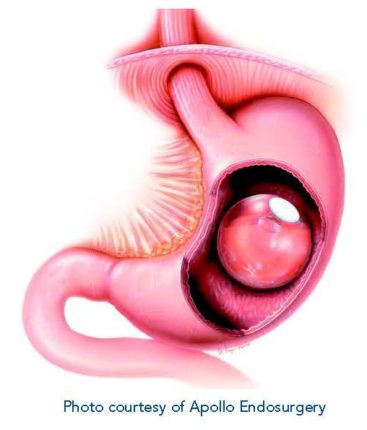
PLEASE NOTE: If you have previously had a specific type of bariatric surgical procedure, you may not be medically eligible for an intragastric balloon. Please discuss this potential issue with your doctor.
What are Intragastric Balloons? Intragastric balloons are soft and durable silicone spheres that take up space in a patient’s stomach. They help reinforce proper portion control by providing a feeling of being full while eating less food.
Who Qualifies for an Intragastric Balloon? Intragastric balloons are intended for adult patients who have a body mass index (BMI) of 30 to 40. Intragastric balloons are also an option for individuals who do not want or do not qualify for more invasive bariatric surgery.
How Does an Intragastric Balloon Work? The ORBERA™ Intragastric Balloon is a single balloon that is inserted into the stomach using an endoscope. It is then filled with saline (saltwater) until it is about the size of a grapefruit. Intragastric balloons occupy some of the existing space in your stomach for six months, serving as built-in portion control. It allows you to feel full and satisfied with less food. After six months, the balloon is removed in the same way it was placed, endoscopically. Through a procedure done under a mild sedative, it is deflated and then removed through the esophagus and mouth.
What Are The Risks? More than 15,000 balloons of the liquid filled type have been placed in the U.S., and over 350,000 have been placed worldwide. The device has been through extensive trials that show relative safety and effectiveness, however, nothing is absolutely safe and without risks. The FDA is doing its job to follow up on the ongoing use of these devices, and intragastic balloon treatment has a mortality rate less than 1 in 10,000, and considered a safe procedure.
Weight-loss: U.S. clinical trial data on ORBERA™ showed that within six months, the average person lost 3.1 times the amount of weight as compared with diet and exercise alone. In real numbers, that means patients with ORBERA™ lost an average of 21.8 pounds (10.2% of their body weight) after the device had been in place for six months. The clinical trial for ORBERA™ also demonstrated that three months after the device was removed (nine months after device placement), ORBERA™ patients maintained an average weight loss of 19.4 pounds. During the trial, those patients who participated in a behavior modification program (diet, exercise, and emotional coaching) but did not receive the ORBERA™ balloon, only lost an average of seven pounds (3.3% of their body weight).
Concerns: Following the procedure, you may experience some discomfort as your stomach gets used to the intragastric balloon. Side effects may include nausea, vomiting, and gastric discomfort during the first week. These symptoms can be alleviated with medications and by working with your HCP. These side effects are normal and are to be expected.
AspireAssistTM (Non-Metabolic) 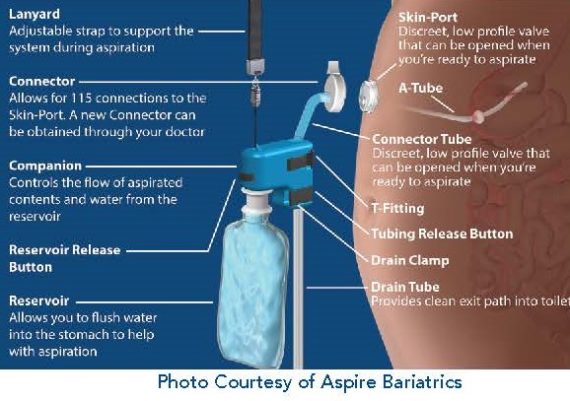
What is AspireAssistTM? AspireAssistTM is a weight-loss device option approved by the FDA. Patients with a BMI between 35 and 55 who have tried to lose weight before may qualify for this device treatment. The device is placed through an outpatient, endoscopic (through your mouth) procedure. The device consists of two components; one implanted inside the patient and one which is used to aspirate following meals.
Weight-loss: Weight-loss with AspireAssistTM generally averages 14% of total body weight following one year of aspiration and lifestyle therapies. At first, weight loss may be higher, but over time the target average is one to two pounds lost per week. Learning to chew food carefully, drink plenty of water with meals, aspirate on a regular basis, and eat a healthier diet are key components to weight-loss success with this device.
After a patient’s goal weight is reached, AspireAssistTM is often left in place for several months to monitor for weight maintenance. HCPs and patients will work together to decide when to remove the device.
How Does AspireAssistTM Work? AspireAssistTM works by using a tube that leads from your stomach to a port that connects to a companion system, which allows for the aspiration of food following meals. The device helps in weight-loss by allowing patients to remove up to 30% of the calories they consume at a meal through aspiration. Patients also learn to eat less and make healthier food choices through lifestyle therapy.
Complications: Following the outpatient procedure, patients may experience abdominal pain or discomfort from the device, implantation discomfort, or nausea and vomiting from the sedation medication. The most common side effect of the device and aspiration therapy is skin irritation at the port site. Less common side effects include infection and continued abdominal pain. Fewer than 4% of patients experienced a serious adverse effect that lead to an overnight hospital stay or could lead to serious harm, and all were treated with medication or device removal.
Conclusion: Studies have shown AspireAssistTM to be a safe and effective weight-loss device option. When used correctly and combined with lifestyle therapy and routine HCP visits, weight-loss was three times higher than with lifestyle modification alone.
Plenity®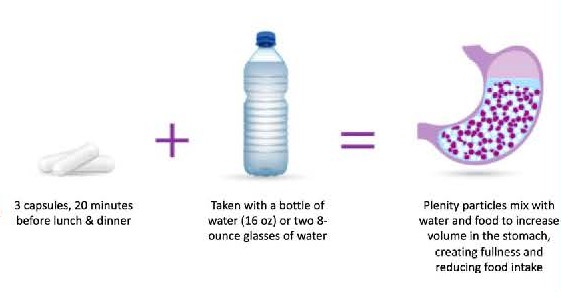
What is Plenity®? Plenity® is a new class of weight-loss options called “super absorbent hydrogels.” Technically, the Food and Drug Administration (FDA) cleared Plenity® as a device, but it is actually a pill (capsule) that is taken daily with lunch and dinner to help with weight loss. Through some impressive food engineering, these capsules release thousands of particles that swell and enlarge in the stomach. The particles then mix with food and travel through the intestines, where they increase fullness and help patients lose weight.
Weight-loss: Plenity®, combined with diet and exercise, may help patients lose an average of 5-10% of their total body weight. Some patients may be extra responsive to Plenity® and lose more weight than others, averaging close to 10% weight loss. Those who tend to “respond better” to Plenity® are those who lose three percent or more of their weight in the first eight weeks of using it. It should also be noted that Plenity® is meant to be used with a proper diet and exercise for the best weight loss outcomes.
How Does Plenity® Work? The pill is swallowed with meals and contains thousands of small particles that expand up to 100 times when taken with water. It has the firmness of solid food similar to vegetables. Plenity® mixes with food in the stomach and travels down the intestines in this enlarged form. The pill expands in the stomach and stays expanded as it works its way through the first part of the intestines. When Plenity® reaches the end of the intestines (colon or large intestine), the water is reabsorbed by the intestines. When the intestines reabsorb the water, the particles shrink down to their original small size and get eliminated with the next bowel movement.
Complications: The most common side effects seen in Plenty® users were GI (digestive system). These side effects include, diarrhea, decreased bowel movements, constipation, abdominal digestion, flatulence (gas) and nausea.
Conclusion: Plenity® can generally be used safely in anyone who wants to lose weight for various reasons. Plenity® moves through the intestines naturally and The results help patients feel fuller, eat less and lose weight.
